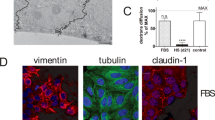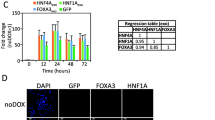Summary
Five different immortalized transgenic hepatocyte cell lines derived from mice were investigated with respect to their potential to maintain the physiological properties of primary hepatocytes using chemically defined medium. This research completes a previous study by Klocke and coworkers in 2002, using gene expression analysis of the same cell lines by the respective physiological analysis for investigating the hepatocyte-like function. Three transgenic cell lines harboring a fusion gene derivative (construct 202), consisting of the complete SV40 early region, including the coding sequences for the transforming large and small tumor antigens, placed under the control of the murine metallothioneine 1-promotor/ enhancer element, showed a hepatocyte-like function and physiology. They grew as a monolayer with a polygonal cell shape, consumed lactate, and secreted albumin at a cell-specific rate of 1.5 pg/h, which is in the range of primary hepatocytes. In addition, the potential of detoxifying ammonium could be maintained. Ammonium was metabolized and urea was produced and released into the medium. A complete urea cycle could be determined. A cell line established from neonatal transgenic mice and expressing a secretory variant of the human epidermal growth factor (IgEGF) under the control of the albumin promoter was characterized by an incomplete urea cycle. Another cell line isolated from the liver of homozygote neonatal p53-knockout mice showed no hepatocyte-specific functions but only properties of continuous cell lines. Specific nucleoside triphosphate (NTP) and uridine (U) ratios were used to characterize the differentiation status of the particular cell lines. A low NTP-U value was found for the thre cell lines containing construct 202, which was identical to that observed for primary hepatocytes. In contrast, the cell line harvested from the liver of homozygote neonatal p53-knockout mice presented a NTP-U ratio characteristic for continuous cell lines. This study demonstrates that the four transgenic and the p53-knockout, hepatocyte-derived cell lines can be used as models for investigating the conservation of tissue-specific functions in immortalized cells.
Similar content being viewed by others
References
Antoine, B.; Levrat, F.; Vallet, V.; Berbar, T.; Cartier, N.; Dubois, N.; Briand, P.; Kahn, A. Gene expression in hepatocyte-like lines established by targeted carcinogenesis in transgenic mice. Exp. Cell Res. 200:175–185; 1992.
Atkinson, D. E. The energy charge of the adenylate pool as a regulatory paramater. Interaction with feedback modifiers. Biochemistry 7:4030–4034; 1968.
Bayad, J.; Bagrel, D.; Sabolovoc, N.; Magdalou, J.; Siest, G. Expression and regulation of drug metabolizing enzymes in an immortalized rat hepatocyte cell line. Biochem. Pharmacol. 42:1345–1351; 1991.
Brinster, R. L.; Chen, H. Y.; Messing, A.; van Dyke, T.; Levine, A. J.; Palmiter, R. D. Transgenic mice harboring SV40 T-antigen genes develop characteristic brain tumors. Cell 37:367–379; 1984.
Brown, P. C.; Papaconstantinou, J. Coordinated modulation of albumin synthesis and mRNA levels in cultures hepatoma cells by hydrocortisone and cyclic AMP analogs. J. Biol. Chem. 254:9379–9384; 1979.
Büntemeyer, H. Fluorescence detection of ammonia. From: methods for offline analysis in animal cell culture. In: Spier, R. E., ed. The encyclopedia of cell technology. New York: Wiley; 2000.
Chou, J. Y. Temperature-sensitive adult liver cell line dependent on glucocorticoid differentiation. Mol. Cell Biol. 3:1013–1020; 1983.
Clayton, D. F.; Darnell, J. E., Jr. Changes in liver-specific compared to common gene transcription during primary culture of mouse hepatocytes. Mol. Cell Biol. 3:1552–1561; 1983.
Clayton, D. F.; Weiss, M.; Darnell, J. E., Jr. Liver-specific RNA metabolism in hepatoma cells: variations in transcription rates and mRNA levels. Mol. Cell Biol. 5:2633–2641; 1985.
Courjault-Gautier, F.; Antoine, B.; Bens, M., et al. Activity and inducibility of drug-metabolizing enzymes in immortalized hepatocyte-like cells (mhPKT) derived from transgenic mouse. Exp. Cell Res. 234:362–372; 1997.
Fitzpatrick, L.; Jenkins, H. A.; Butler, M. Glucose and glutamine metabolism of a murine B-Lymphocyte hybridoma grown in batch culture. Appl. Biochem. Biotechnol. 43:93–116; 1993.
Fox, I. J.; Roy Chowdhury, N.; Gupta, S.; Kondapalli, R.; Schilsky, M.; Stockert, R. J.; Roy Chowdhury, J. Conditional immortalization of Gunn rat hepatocytes: an ex vivo model for evaluating methods for bilirubin-UDP-glucoronyltransferase gene transfer. Hepatology 21:837–846; 1995.
Glacken, M. W. Catabolic control of mammalian cell culture. Biotechnology 6:1041–1050; 1988.
Guguen-Guillouzo, C.; Clement, B.; Baffet, G.; Beaumont, C.; Morel-Chany, E.; Glaise, D.; Guillouzo, A. Maintenance and reversibility of active albumin secretion by adult rat hepatocytes co-cultured with other liver epithelial cell type. Exp. Cell Res. 143:47–54; 1983.
Hoffmann, B.; Piasecki, A.; Paul, D. Proliferation of fetal rat hepatocytes in response to growth factors and hormones in primary culture. J. Cell. Physiol. 139:654–662; 1989.
Itoh, Y.; Okanoue, T.; Enjo, F.; Sakomoto, S.; Takami, S.; Jasui, K.; Kagawa, K.; Kashima, K. Regulation of hepatic albumin and alpha-1-acid glycoprotein secretion by monokines, dexamethasone and nitric oxide synthetase pathway. Dig. Dis. Sci. 39:851–860; 1994.
Jat, P. S.; Sharp, P. A. Cell lines established by a temperature-sensitive simian virus 40 large T-antigen gene are growth restricted at the nonpermissive temperature. Mol. Cell Biol. 9:1672–1681; 1989.
Kim, B. H.; Sung, S. R.; Choi, E. H., et al. Dedifferentiation of conditionally immortalized hepatocytes with long-term in vitro passage. Exp. Mol. Med. 32:29–37; 2000.
Klocke, R.; Gómez-Lechón, M. J.; Ehrhardt, A.; Mendoza-Figueroa, T.; Donato, M. T.; López-Revilla, R.; Castell, J. V.; Paul, D. Establishment and characterization of immortal hepatocytes derived from various transgenic mouse cell lines. Biochem. Biophys. Res. Commun. 294:864–871; 2002.
Lanks, K. W.; Li, P. W. End products of glucose and glutamine metabolism by cultured cell lines. J. Cell. Physiol. 135:151–155; 1988.
Larsen, B. R.; West, F. G. A method for quantitative amino acid analysis using precolumn o-phthaldialdehyde derivation and high performance liquid chromatography. J. Chromatogr. Sci. 19:259–265; 1981.
Liddle, C.; Goodwin, B. J.; Tapner, M. Culture and transfection of mammalian primary hepatocytes and hepatocyte-derived cell lines. J. Gastroenterol. Hepatol. 13:855–858; 1998.
Lin, A. A.; Nguyen, T.; Miller, W. M. A rapid method for counting cell nuclei using a particle size/counter. Biotechnol. Techniques 5:153–156; 1991.
Liu, J.; Pan, J.; Naik, S., et al. Characterization and evaluation of detoxification functions of a nontumorigenic immortalized porcine hepatocyte cell line (HepLiu). Cell Transplant. 8:219–232; 1999.
Morin, O.; Normand, C. Long-term maintenance of hepatocyte functional activity in co-culture: requirements for sinusoidal endothelial cells and dexamethasone. J. Cell. Physiol. 129:103–110; 1986.
Nakamura, J.; Okamoto, T.; Schumacher, I. K.; Tabei, I.; Roy Chowdhury, N.; Roy Chowdhury, J.; Fox, I. J. Treatment of surgically induced acute liver failure by transplantation of conditionally immortalized hepatocytes. Transplantation 15:1541–1547; 1997.
Naslund, B.; Stahle, L.; Lundin, A.; Anderstam, B.; Arner, P.; Bergström, J. Luminometric single step urea assay using ATP-hydrolyzing urease. Clin. Chem. 44:1964–1973; 1998.
Neermann, J.; Wagner, R. Comparative analysis of glucose and glutamine in transformed mammalian cell lines, insect and primary liver cells. J. Cell. Physiol. 166:152–169; 1996.
Negrotti, M., Murray, K.; Reidy, T. J.; Krok, K.; Seaver, S. S. Effects of glutamine and ammonia on hybridoma cell proliferation and antibody production [abstract]. In: Proceedings of second Engineering Foundation conference on animal cell culture, Santa Barbara, CA. 1989; 65.
Newsholme, P.; Gordon, S.; Newsholme, E. A. Rates of utilization, and fates of glucose, glutamine, pyruvate, long-chain fatty acids and ketone bodies by mouse macrophages. Biochem. J. 242:631–636; 1987.
Palmiter, R. D.; Chen, H. Y.; Messing, A.; Brinster, R. L. SV40 enhancer and large T-antigen are instrumental in development of choroid plexus tumours in transgenic mice. Nature 316:457–460; 1985.
Paul, D.; Höhne, M.; Pinkert, C.; Piasecki, A.; Ummelmann, E.; Brinster, R. L. Immortalized differentiated hepatocyte cell lines derived from transgenic mice harbouring SV40 T-antigen genes. Exp. Cell Res. 175:354–362; 1988.
Perraud, F.; Dalemans, W.; Gendrault, J. L.; Dreyer, D.; Ali-Hadji, D.; Faure, T.; Pavirani, A. Characterization of trans-immortalized hepatic cell lines established from transgenic mice. Exp. Cell Res. 195:59–65; 1991.
Petch, D.; Butler, M. Profile of energy metabolism in a murine hybridoma: glucose and glutamine utilization. J. Cell. Physiol. 161:71–76; 1994.
Pfeifer, A. M.; Cole, K. E.; Smoot, D. T., et al. Simian Virus 40 large T-Antigen immortalized normal human epithelial cells express hepatocyte characteristics and metabolize chemical carcinogens. Proc. Natl. Acad. Sci. USA 90:5123–5127; 1993.
Reitzer, L. J.; Wice, B. M.; Kennell, D. Evidence that glutamine, not sugar, is the major energy source for cultured HeLa cells. J. Biol. Chem. 254:2669–2676; 1979.
Rocker, D. Characterization of primary liver cells in sandwich configuration. Long-term cultivation under maintenance of the hepatic properties. Ph.D. Thesis. Technische Universität, Braunschweig, Germany; 1999.
Rojkind, M.; Gatmaitan, Z.; Mackensen, S.; Giambrone, M. A.; Ponce, P.; Reid, L. M. Connective tissue biomatrix: its isolation and utilization for long-term cultures of normal rat hepatocytes. J Cell Biol. 87:255–263; 1980.
Ryll, T.; Lucki-Lange, M.; Jäger, V.; Wagner, R. Production of recombinant human interleukin-2 with BHK-cells in a hollow fibre and a stirred tank reactor with protein-free medium. J. Biotechnol. 14:377–392; 1990.
Ryll, T.; Wagner, R. Improved ion-pair high-performance liquid chromatographic method for the quantification of a wide variety of nucleotides and sugar-nucleotides in animal cells. J. Chromatogr. 570:77–88; 1991.
Ryll, T.; Wagner, R. Intracellular ribonucleotide pools as a tool for monitoring the physiological state of in vitro cultivated cells during production process. Biotechnol. Bioeng. 40:934–946; 1992.
Schippers, I. J.; Moshage, H.; Roelofson, H.; Müller, M.; Heymans, H. S. A.; Ruiters, M.; Kuipers, F. Immortalized human hepatocytes as a tool for the study of hepatocytic de-differentiation. Cell Biol. Toxicol. 13:375–386; 1997.
Schumacher, I. K.; Okamoto, T.; Kim, B. H.; Roy Chowdhury, N.; Roy Chowdhury, J.; Fox, I. J. Transplantation of conditionally immortalized hepatocytes to treat hepatic encephalopathy. Hepatology 24:337–343; 1996.
Stutenkemper, R.; Geisse, S.; Schwarz, H. J.; Look, J.; Traub, O.; Nicholson, B. J.; Willecke, K. The hepatocyte-specific phenotype of murine liver cells correlates with high expression of connexin32 and connexin 26 but very low expression of connexin43. Exp. Cell Res. 201:43–54; 1992.
Takagi, M.; Kojima, N.; Yoshida, T. Analysis of the ammonium metabolism of rat primary hepatocytes and a human hepatocyte cell line Huh 7. Cytotechnology 32:9–15; 2000.
Tönjes, R. R.; Löhler, J.; O'Sullivan, J. F.; Kay, G. F.; Schmidt, G. H.; Dalemans, W.; Parivani, A.; Paul, D. Autocrine mitogen IgEGF cooperates with c-myc or with the Hcs locus during hepatocarcinogenesis in transgenic mice. Oncogene 10:765–768; 1995.
Tritsch, G. L.; Moore, G. E. Spontaneous decomposition of glutamine in cell culture media. Exp. Cell Res. 28:360–364; 1962.
Woodworth, C. D.; Isom, H. C. Regulation of Albumin gene expression in a series of rat hepatocyte cell lines immortalized by Simian Virus 40 and maintained in chemically defined medium. Mol. Cell Biol. 10:3740–3748; 1987.
Yanai, N.; Suzuki, M.; Obinata, M. Hepatocyte cell lines established from transgenic mice harboring temperature-sensitive simian virus 40 large T-antigen gene. Exp. Cell Res. 197:50–56; 1991.
Yoon, J. H.; Lee, H. V. S.; Lee, J. S.; Park, J. B.; Kim, C. Y. Development of a non-transformed human liver-cell line with differentiated-hepatocyte and urea-synthetic functions: applicable for bioartificial liver. Int. J. Artif. Organs 22:769–777; 1999.
Zielke, H. R.; Ozand, P. T.; Tilson, J. T. Reciprocal regulation of glucose and glutamine utilisation by cultured human diploid fibroblasts. J. Cell. Physiol. 95:41–48; 1978.
Zielke, H. R.; Sumbilla, C. M.; Sevdalian, D. A.; Hawkins, R. L.; Ozand, P. T. Lactate: a major product of glutamine metabolism by human diploid fibroblasts. J. Cell. Physiol. 104:433–441; 1980.
Author information
Authors and Affiliations
Corresponding author
Rights and permissions
About this article
Cite this article
Priesner, C., Hesse, F., Windgassen, D. et al. Liver-specific physiology of immortal, functionally differentiated hepatocytes and of deficient hepatocyte-like variants. In Vitro Cell.Dev.Biol.-Animal 40, 318–330 (2004). https://doi.org/10.1290/0404031.1
Received:
Accepted:
Issue Date:
DOI: https://doi.org/10.1290/0404031.1




